FDM (fused deposition modeling) 3D printers, better known as filament 3D printers, come in a wide range of models, at a wide range of prices, with many different features.
The feature we’re going to talk about is the filament runout sensor. As you might imagine, this sensor tells the printer when it runs out of filament.
On printers with a smaller build area, this might not be all that important. That’s because it’s less likely that you’ll run out of a spool of filament with a printer that can’t print anything particularly large.
But what about large printers with large build areas? It’s entirely possible you’ll want to print something that will take more than one spool of filament.
Filament typically comes in 1kg spools. Yes, there are smaller spools available, as well as larger ones, but larger spools tend to get unwieldy. Remember that the spool has to unwind to feed the filament. The bigger the spool, the greater the pull force required. Also the bigger the spool, the larger the spool holding rig required.
I like to keep one of my printers loaded with ColorFabb’s PLA Economy White, which comes in a 2.2kg spool. It’s convenient for some of the bulk printing I do for some of our family projects.
That said, a good 90% of the time, I’m using a 1kg spool. As the attached video shows, a 1kg spool doesn’t hold enough filament for some prints.
The problem is, many printers don’t know when you run out of filament. They just pull in filament using a geared mechanism. That mechanism does no reporting back to the printer. It just feeds, melts, and extrudes.
Some printers, though, do have a sensor — called a filament runout sensor or a filament break sensor — that tells when a spool is empty or no filament is feeding. These sensors report back to the printer’s internal processor. When a runout is reported, the printer moves the print head away from the print and lets everything cool down until you replace the filament.
Once you load a new spool and thread the filament through the extruder, you can tell the printer to continue. If everything works, printing picks up right where it left off.

Aria the Dragon ran out of white filament, so a little silver filament finished off her wings nicely.
The printer in the attached video is the $6,000 Ultimaker S5. But you don’t need a super-expensive printer to have a filament runout sensor. The Creality Sermoon D1 is one-tenth the price, at $599, but it also comes with a filament runout sensor. Stay tuned. I’ll have a full review on the Sermoon D1 up soon.
Even if your printer doesn’t come with such a sensor, you can often add it. I’m linking to an $8 BIQU sensor that you can add to most printers.
I’m usually pretty good at working with the slicing program to estimate the amount of filament needed for my prints. But I have found myself relying on runout sensors, both for big prints and for spools that just happen to be near their end, as was the case with my print of Aria the Dragon.
My practical 3D printing advice is simple: if you’re buying a new 3D printer, get one with a filament runout sensor. If you don’t have one, see if it can be added and invest a few bucks to upgrade your printer. It’s an inexpensive upgrade that can save you both time and money.
What’s your favorite 3D printer feature? Do you have a filament runout sensor? Do you have a 3D printer? Let’s talk 3D printing in the comments below.
You can follow my day-to-day project updates on social media. Be sure to follow me on Twitter at @DavidGewirtz, on Facebook at Facebook.com/DavidGewirtz, on Instagram at Instagram.com/DavidGewirtz, and on YouTube at YouTube.com/DavidGewirtzTV.























